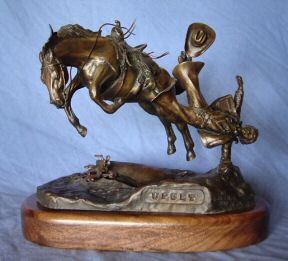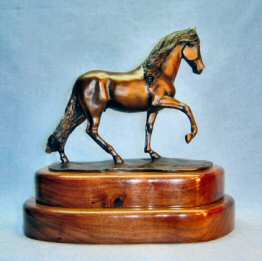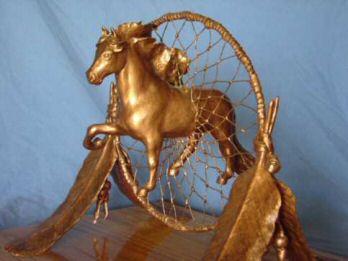
"UPSET" © 2003 by Nadine L. Meade
$1,875 Contact Nadine to verify availability and to purchase.

To view larger image and further information about this bronze click on photo or click here.
"Peruvian Futurity" © 2004 by Nadine L. Meade

To view larger image click on photo or click here.
Clay sculpture "Dream Catcher" left side close up.
"Dream Catcher" is a one of a kind clay sculpture of a Peruvian horse coming through a dream catcher.
SOLD Thank You Don and Bobbi Taylor!Fun Art Sculptures
Lost Wax Bronzing
There are a lot of different ways of doing things, like creating directly in wax instead of clay, and I believe the foundry can work from items not made of clay, but below is the basic procedure that created my bronzes, known as the, "lost wax" process.
To make my sculptures I create my design in a special clay that doesn't dry, it melts when heated. At this stage the work can have extra support exposed which will later be removed. An example of what I mean is for the sculpture UPSET I created a wire armature, which had a metal rod coming down from the horse's belly into the base. When I had the details as I wanted in clay, I then took it to a foundry. At the foundry they cut the piece into workable sections that basically have 2 sides. Such as for a horse they might cut the two left legs off and the man (in UPSET) was cut loose from the base at about his wrist. They then cover the pieces with silicone, then a plaster type outside covering to support the silicone. The molds are removed from the clay and the pieces are poured full of wax. The mold is removed from the wax and the foundry has a room of artisans who reassemble the wax pieces to the original design. At this point I go and check the wax for my piece, and made the changes necessary to make the wax like my original clay design. I understand that some artist do the entire mold process and take the mold to the foundry, while other artist don't go make sure the wax is the same as the original clay was, but this is the way I did UPSET, and it seems to be a very common way of doing it and I wanted to be sure my bronze matched my original clay design. Once the wax is ready the foundry sprays a coating over it to a uniform thickness, lets that cure and then heats it. When it is heated the sprayed on coating turns to glass right before the wax melts and runs out of vent holes which were left during the mold making process. (realize the original mold maker had to figure out where and how many drain/vent lines would be needed to allow the wax and bronze to flow to all portions of the mold.)At this point they have a glass mold of my piece. The bronze UPSET was actually a rather complicated piece and as such was still in several pieces at this stage. The hot molten bronze is then poured into the glass mold and allowed to cool. Once cool the glass is hit to break it off of the bronze. The bronze is then sand blasted to remove any remaining glass and the pieces are welded together and ground back to the necessary dimensions, small items like the cactus and the reins are applied. The reins are made of copper wire which is rolled to flatten it to look like leather reins. In a miniature piece like UPSET realize this is very fine, detailed work. A patina is then applied. There are a lot of patinas now available, and there are several steps to applying it. The first step, to get the finish which I used, is to apply gun bluing. It is then rubbed with steel wool to lighten the highlighted areas, then the color is sprayed on. It is then sealed or waxed as desired and attached to a wooden base.
There are lots of details not included above, like the use a spray between my original clay and the silicone to make it release easier. Certain types of wire work better for the armature because it is easier for them to cut the pieces apart before making the mold from the original piece...and they take lots of photos of my original clay to assist in their reassembly of the waxes. As in any art form there are lots of details to get right to make a quality finished product.
I have been very happy with the work from the foundry which I've chosen to work with, The Bronze Horse, located in Pawahuska, OK. They stay very busy though, and to get a piece cast, between the time required for them to complete the process and the waiting they list they seem to always have, it takes about 4 months to get a piece cast.
When I took my clay for UPSET to have it bronzed it was enough different in it's support system from anything they had done that they were unsure if it would be strong enough to support the weight of the horse, as the support is entirely through the arm and stirrup leather, which holds up the entire horse. After it was welded together the gentleman doing the work slapped the horses rump really hard and said it was plenty strong! :) The way I carry it is by reaching under the horses flank with one hand. The completed sculpture weighs 13.5 lbs.
One disadvantage to working in this type of clay is that if I decide not to make a bronze from a piece I've created I can't cure it and have a one of a kind clay piece, as is possible with some types of clay. I currently have one Peruvian foal that I made in clay and have never made the trip up to the foundry to get made into a bronze.
Today's date is , and you are visitor number


 to this page.
to this page. Return to Top | Next Page | Back One Page
Home | Latest |Paintings | Sculptures | Drawings | Fun Art | Biography |Contact Nadine |Site Map |Guest Book |Links